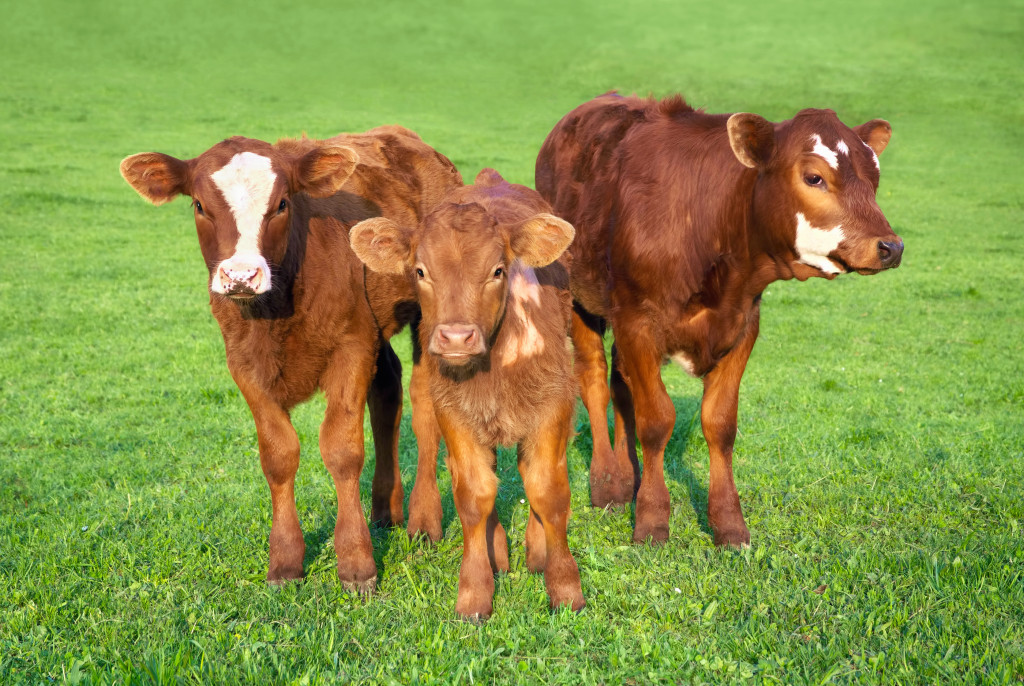- Appropriate agricultural equipment, such as paddocks, hay feeders, buckets, troughs, and feed supplements, is essential for successful cattle management.
- It is important to understand the specific feed requirements of the breed of cattle to ensure their well-being.
- Housing and shelter should protect from the elements and provide enough physical space, while secure fencing should be in place.
- Healthcare protocols should be adopted with the help of a veterinarian, and vaccinations should be administered according to local protocols.
Raising cattle can be a rewarding experience, but it’s important to understand the basics of proper care and management. Many factors need to be considered when raising cattle. Considering all these things before starting a cattle operation, you can help ensure your business runs smoothly for years.
Appropriate Agricultural Equipment
Thinking ahead and thoroughly considering appropriate agricultural equipment is essential when raising cattle. From paddocks to hay feeders, buckets, troughs, and feed supplements, farmers must know the types of cattle-handling products necessary for their animals’ comfort, safety, and growth.
Each piece is critical and should be carefully selected based on knowledge about what best suits their herd. For prosperity, ensuring the right nutritional elements are available to allow the animals to thrive is important. It is also essential that farmers provide secure fencing and handling equipment so they can perform routine tasks as safely and efficiently as possible.
In summary, researching which cattle-raising equipment is most suitable for a particular farm requires research. Still, it will help ensure better management of the animals while providing them with a healthy environment that contributes to weight gain and improves overall well-being.
Cattle Care Essentials
Considering the essentials for cattle care is key to a successful operation. Here are the primary cattle care essentials:
Feed Requirements

Feeding cattle is an important part of properly caring for them. Understanding their feed requirements is essential in ensuring their well-being and optimal growth. Feed requirements vary based on the age, type, and size of a particular breed of cattle and their environment. Generally, depending on their nutritional needs, cattle should be provided with fresh forage such as hay or pasture grass supplemented by grain or other protein sources.
It is important to monitor how much each animal consumes and adjust the food amount if necessary. Finally, providing clean drinking water is essential to ensure your cows stay hydrated. By taking the time to understand one’s cattle’s feed requirements and providing them according to their individual nutritional needs, you can be sure that your animals are healthy and thriving.
Housing & Shelter
It is necessary to provide suitable living conditions for cattle to live free from stress and thrive in their environment. Providing adequate housing should be a priority for breeders of all levels. Appropriate housing will protect the animals from the elements, such as rain, wind, cold temperatures, or hot climates.
Additionally, proper housing should have enough physical space inside to prevent overcrowding which can cause undue stress on the animals and hinder their ability to move around. A well-designed shelter can also improve feed efficiency and milk production resulting in a healthier herd overall.
Cattle need adequate protection from predators, a comfortable resting area, good ventilation, and plenty of feed accessible inside the house when needed. Secure fencing around pasture areas should also be considered during this process. All these factors should be considered when determining an appropriate shelter that meets the needs of cattle and increases efficiency in production levels.
Healthcare

Cattle are exposed to a variety of infectious diseases that need to be addressed and managed properly with the help of vaccinations. Producers should adopt herd health protocols and provide adequate nutrition, facilities, and management that minimize stress, as this can lead to reduced productivity and increased susceptibility to diseases. Vaccinations should be regularly administered according to local protocols and updated with the latest veterinary recommendations.
Also, it’s wise to establish a relationship with a veterinarian with ample experience in working with cattle so that frequent monitoring of herd health can be executed for signs of illness or unhealthy practices to become visible as quickly as possible. Effective cattle healthcare is paramount for animal well-being, food safety, disease prevention, and sustainable beef production.
Nutrition
A healthy diet for cattle should include adequate amounts of carbohydrates, proteins, and fats in the correct ratios. Additionally, vitamins and minerals should also be included in their diets. Cattle require an abundance of fresh, high-quality hay or pasture grass and ample access to clean water throughout the day.
Without proper nutrition, usually made up of appropriate grasses and grain concentrates, cattle may suffer from growth disorders, lack of weight gain, and an overall decreased immune system response. Properly caring for cattle through dietary considerations is beneficial to the animal’s health and can create tastier produce such as beef products that are sought after by many consumers.
Climate Considerations
Climate considerations are an extremely important factor to consider when raising cattle. This refers to an assessment and implementation of practices that reduce the environmental impacts of cattle production and improve the sustainability of operations.
When done properly, climate considerations can help mitigate the risk of damage associated with changes in climate such as soil degradation, decreased grazing land availability, and increased water scarcity. Climate considerations also increase the efficiency of operations by increasing yield, animal health, and longevity without relying on additional inputs such as feed, medicines, or fertilizers.
These are just a few of the considerations necessary for successful cattle management. If you invest the time and effort to examine these essential elements, your animals will remain strong and productive for a long period.




